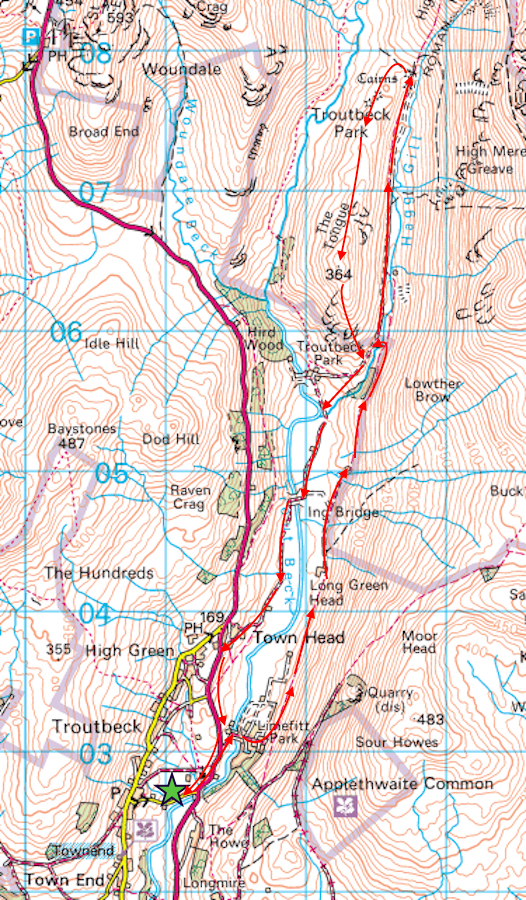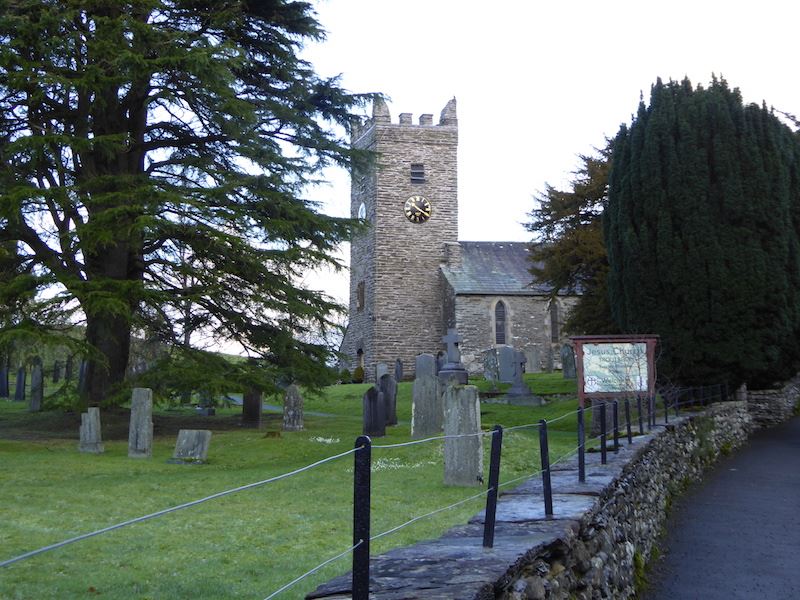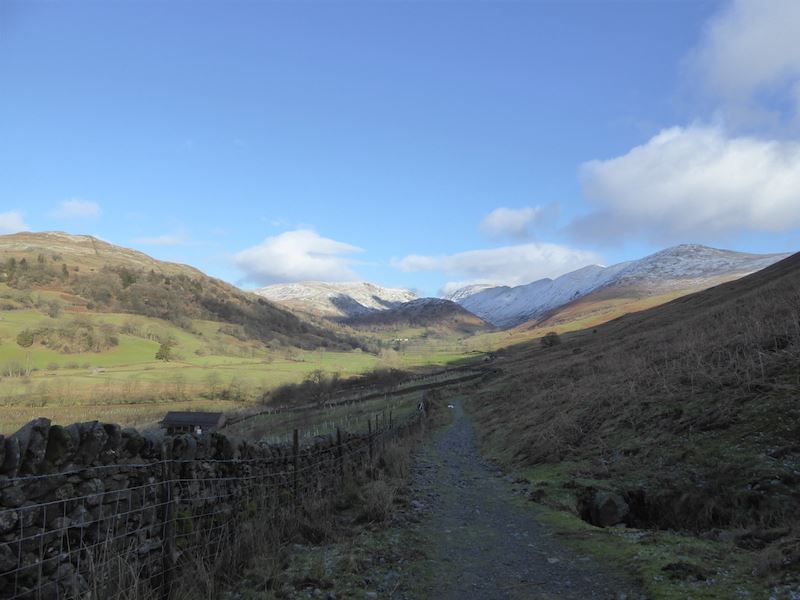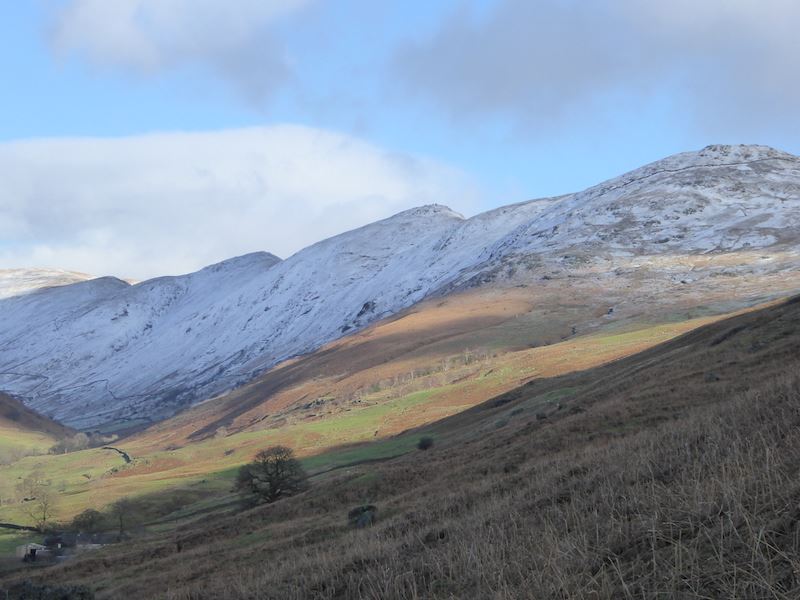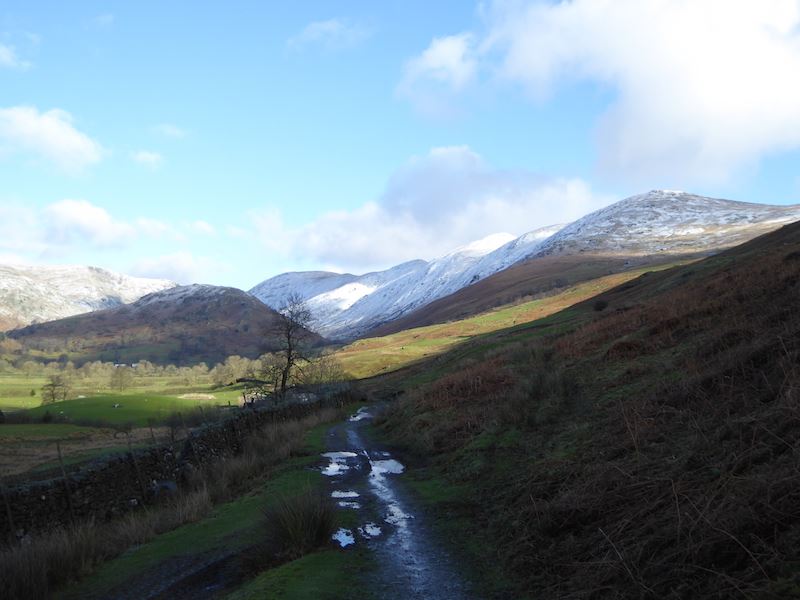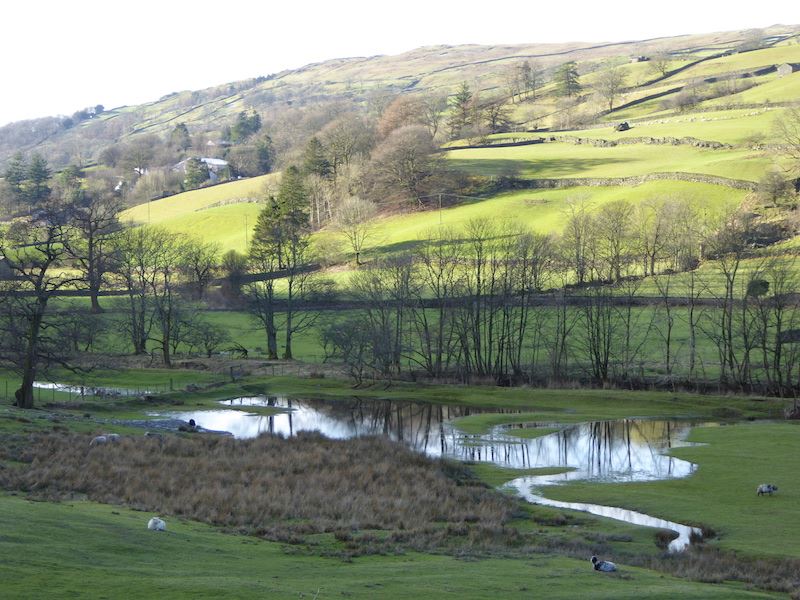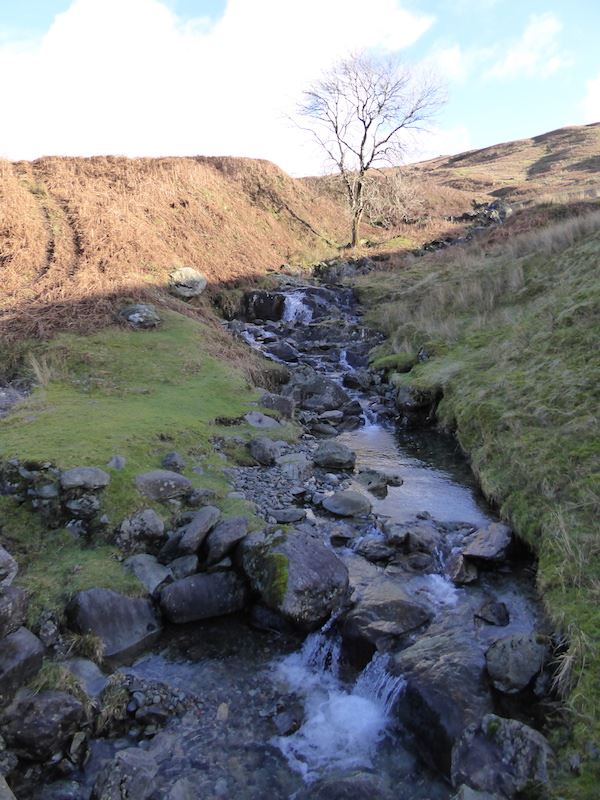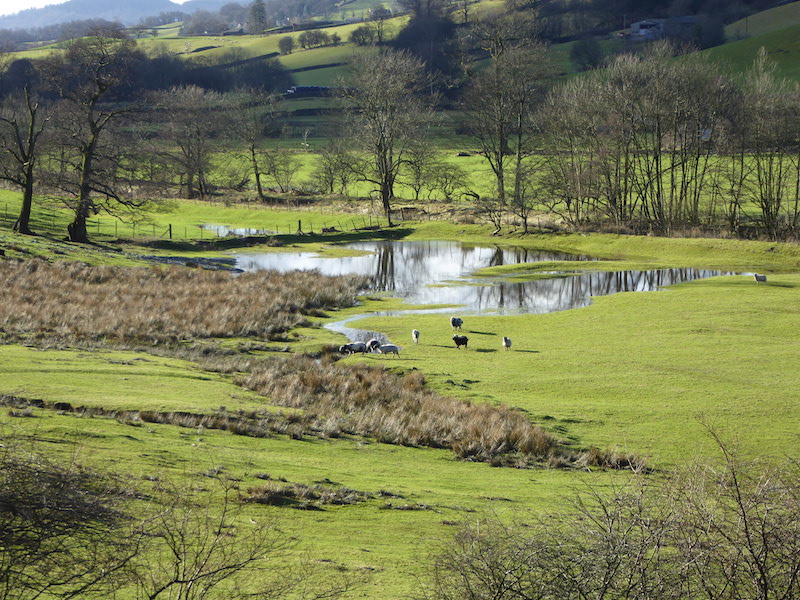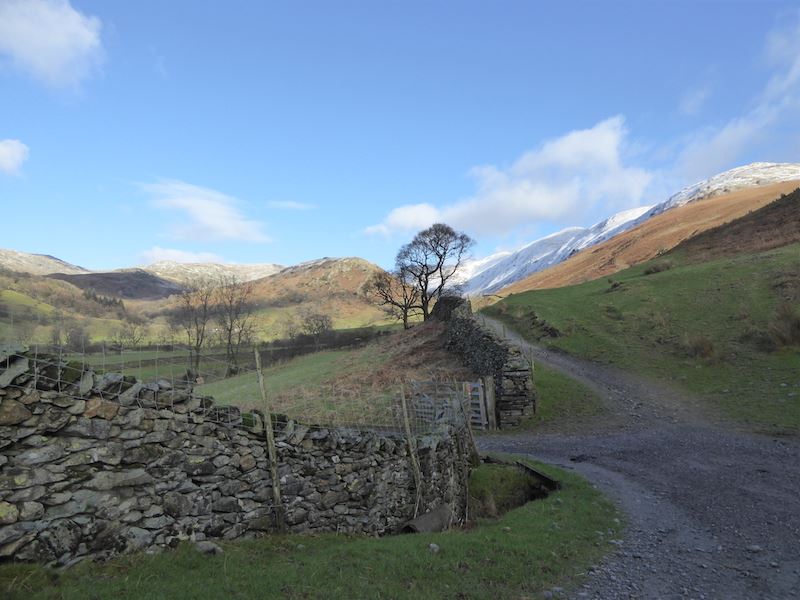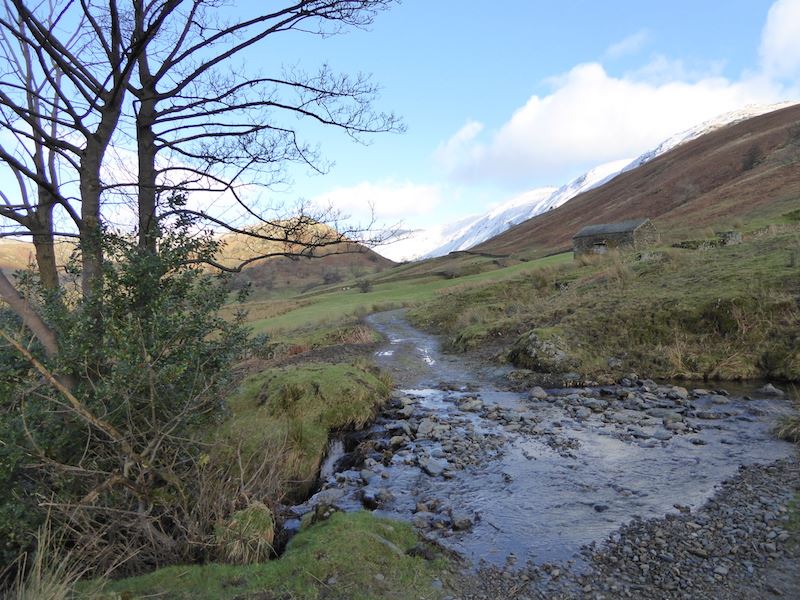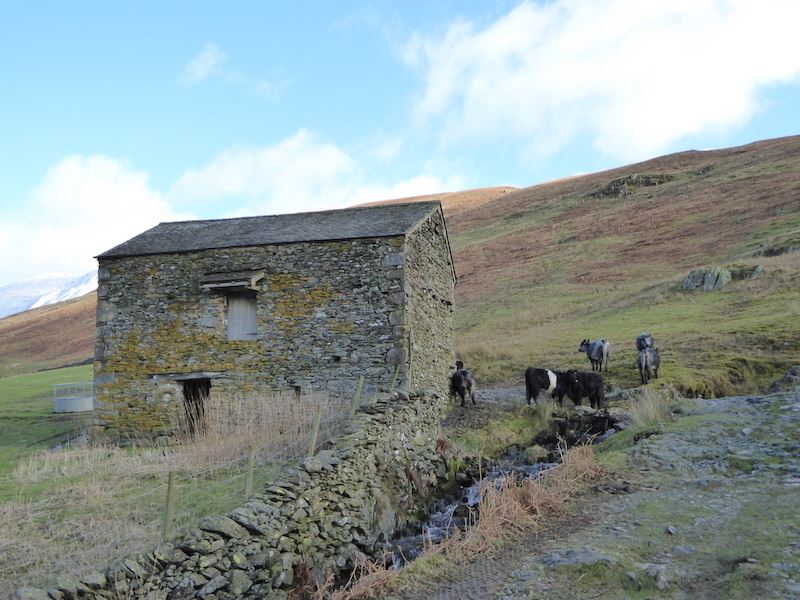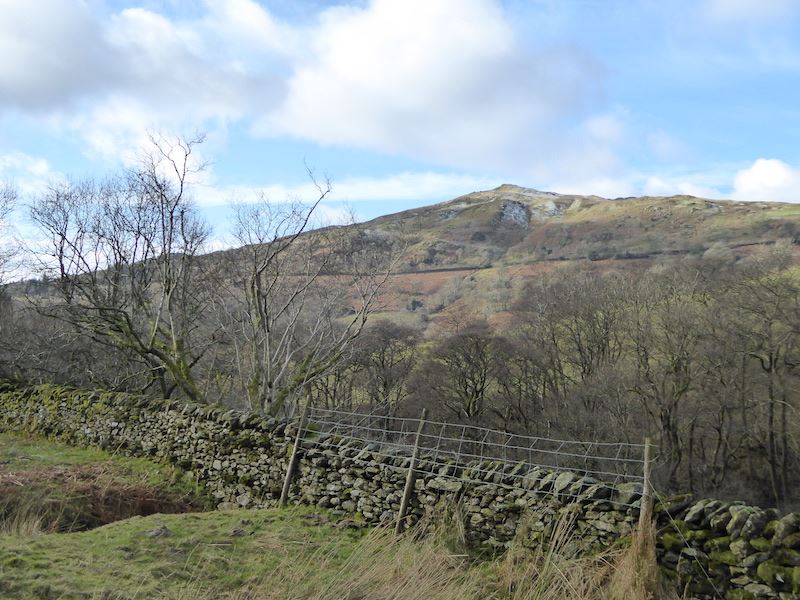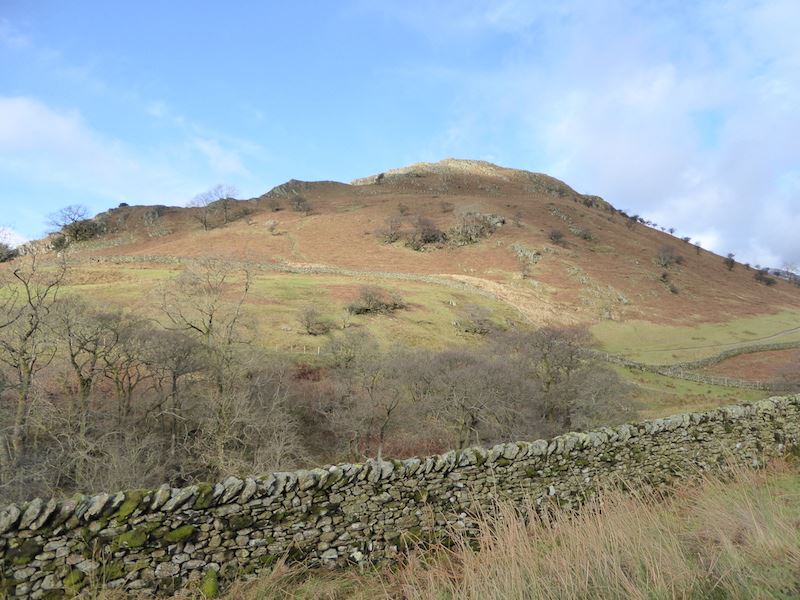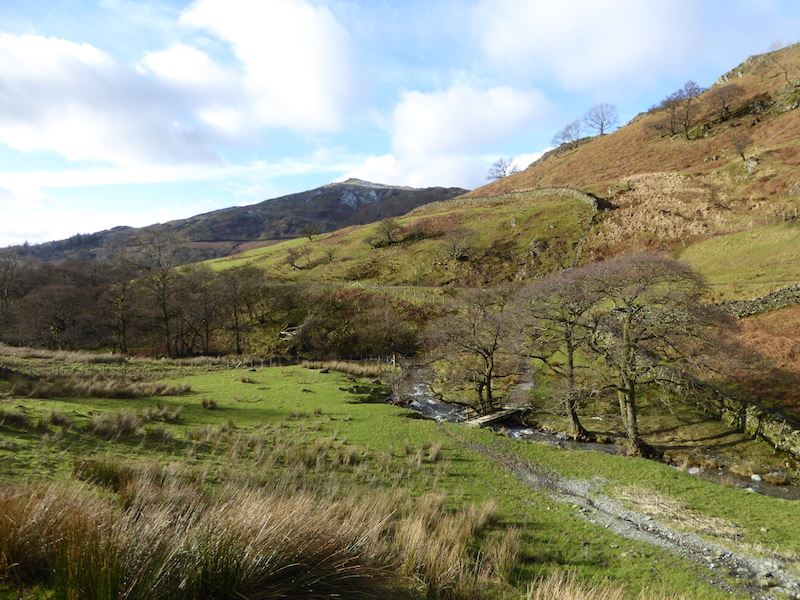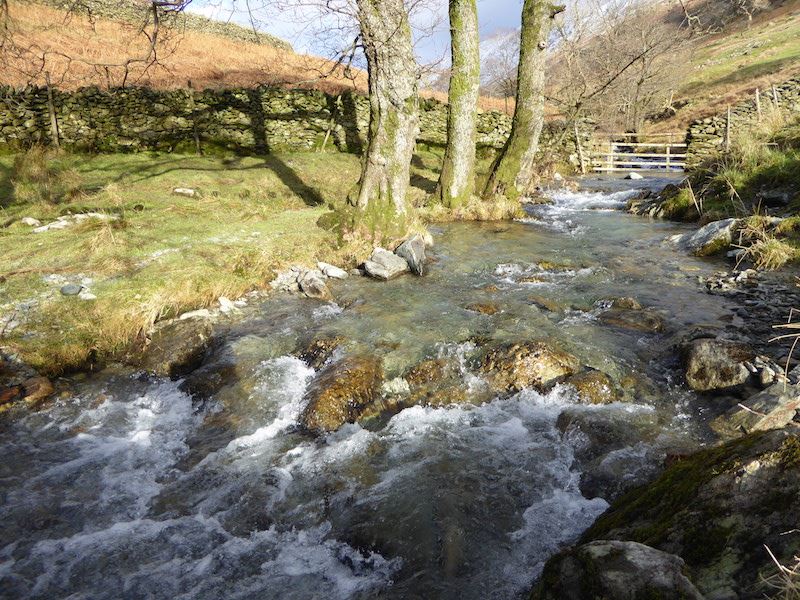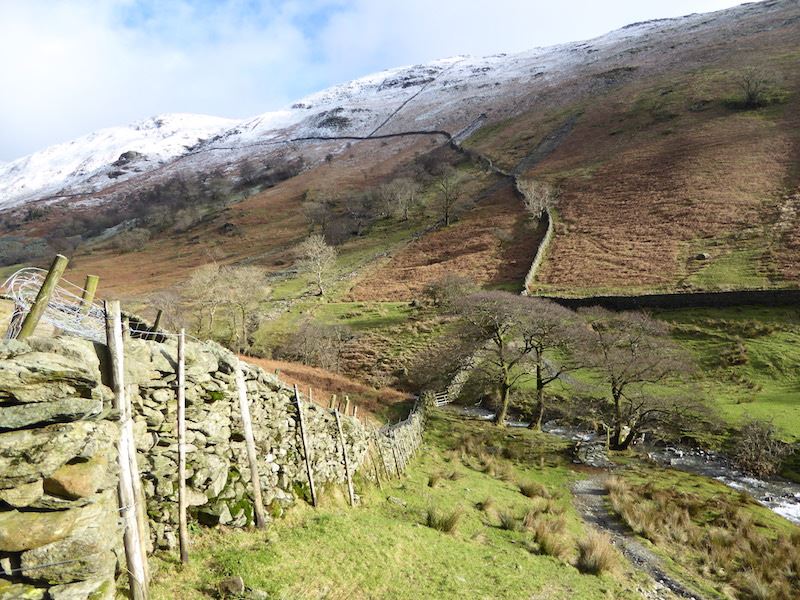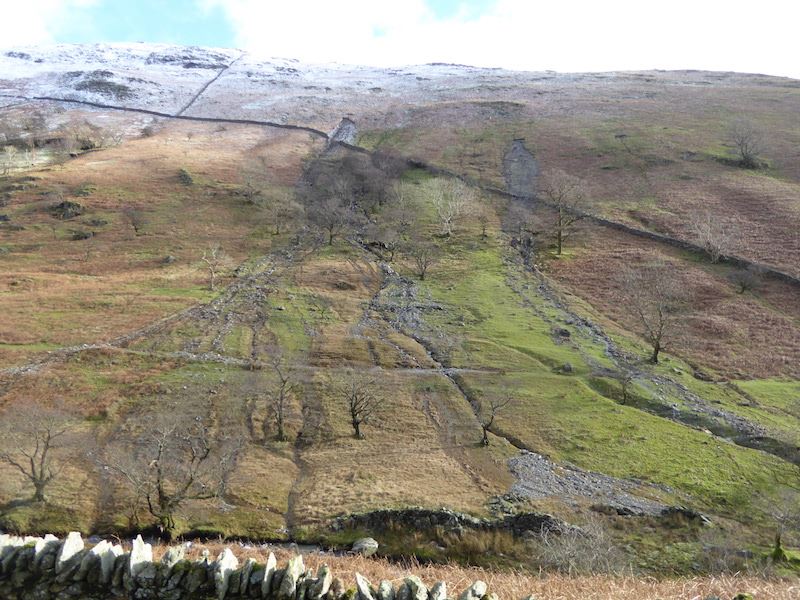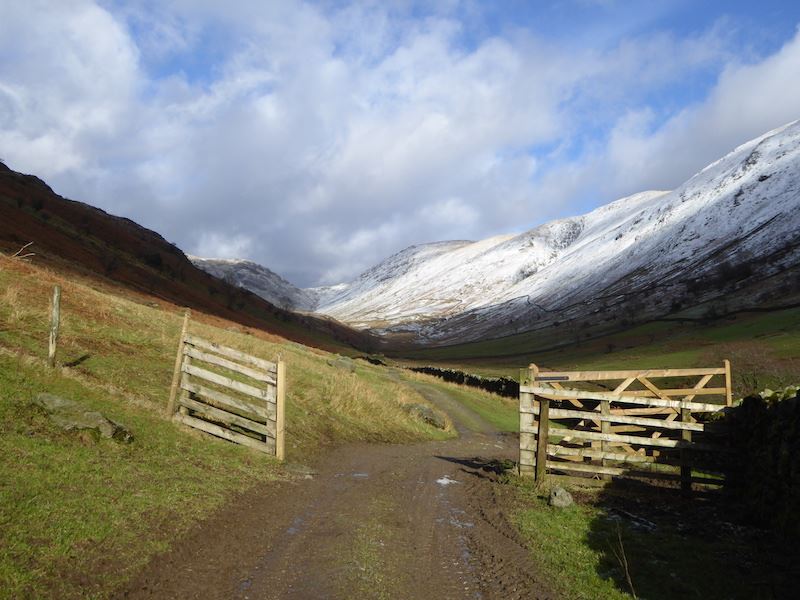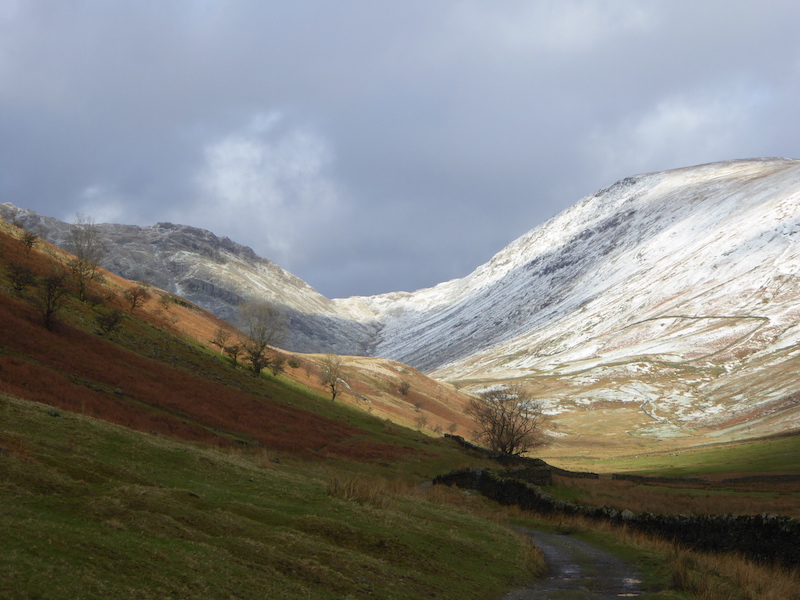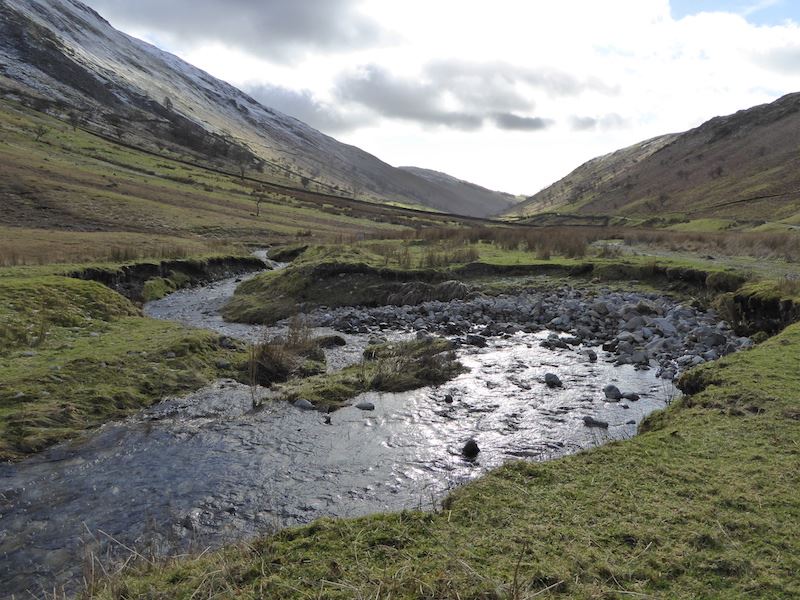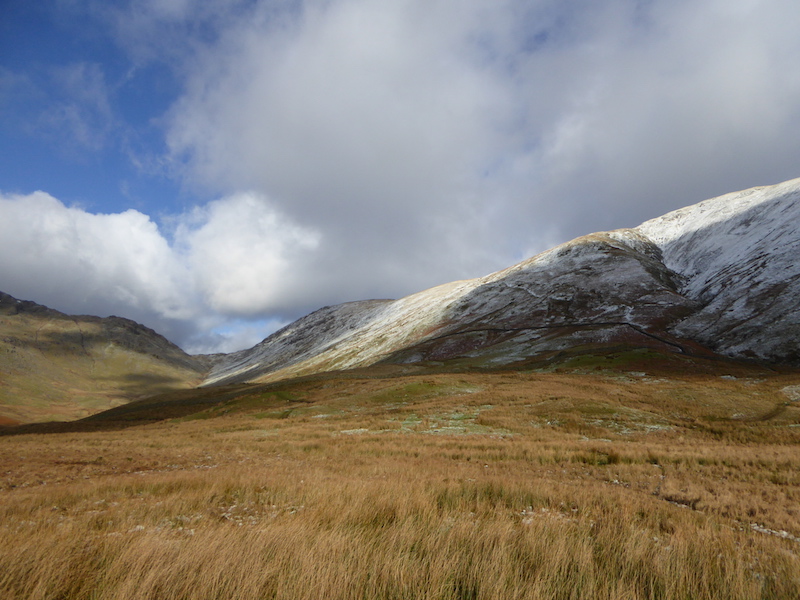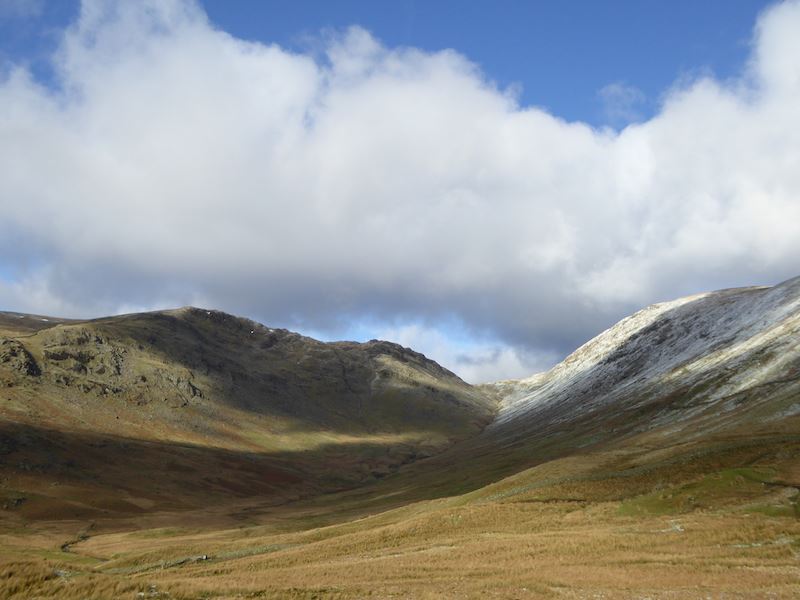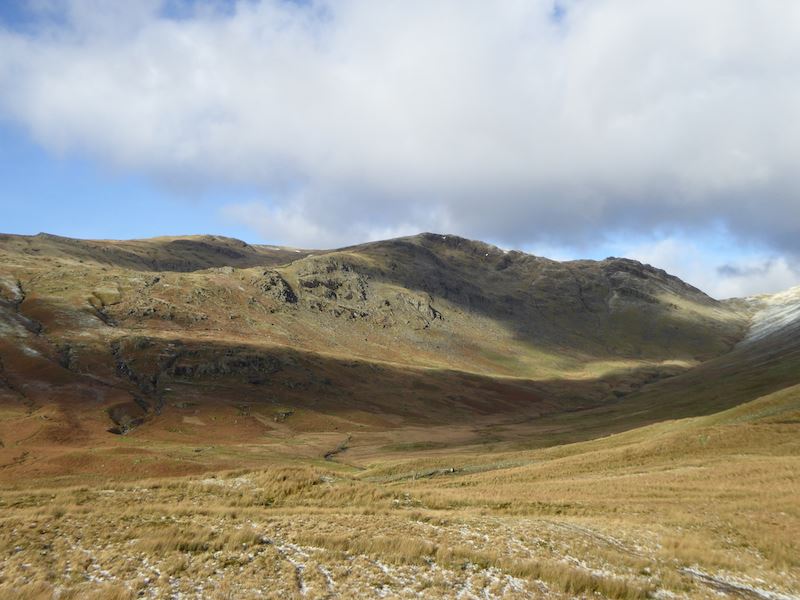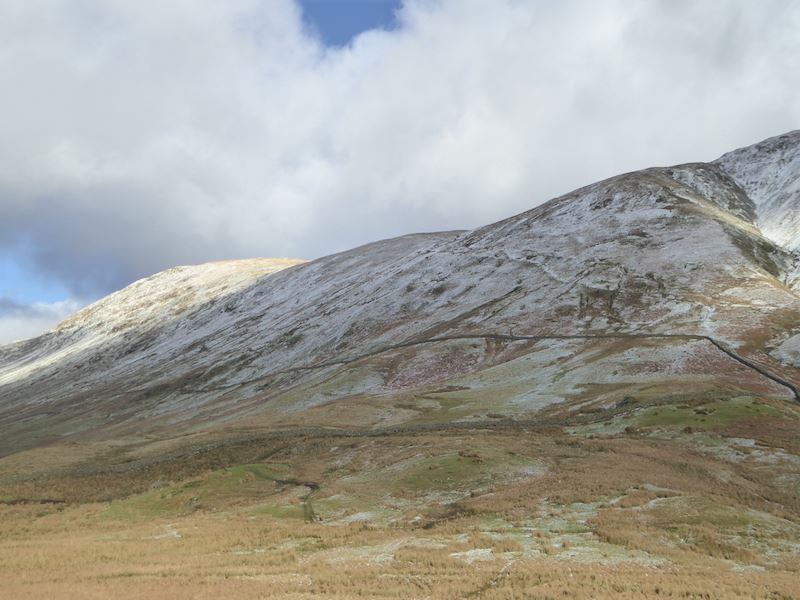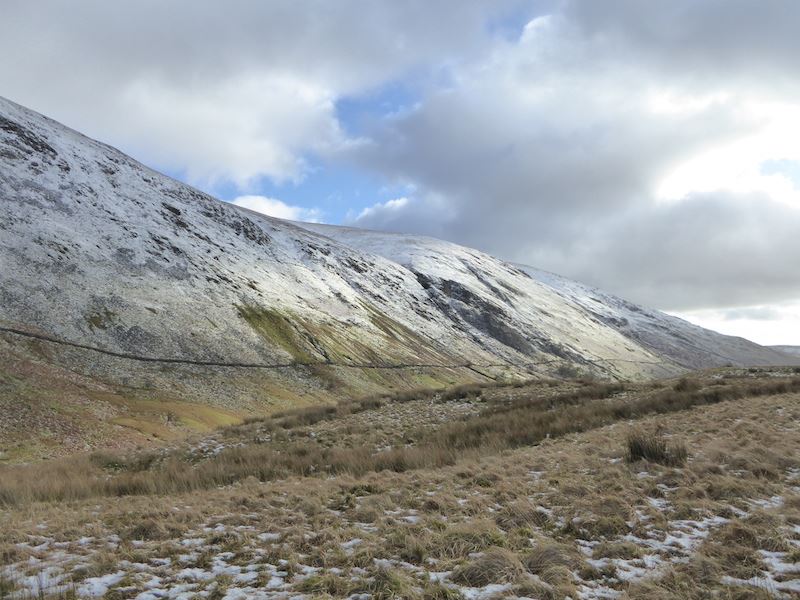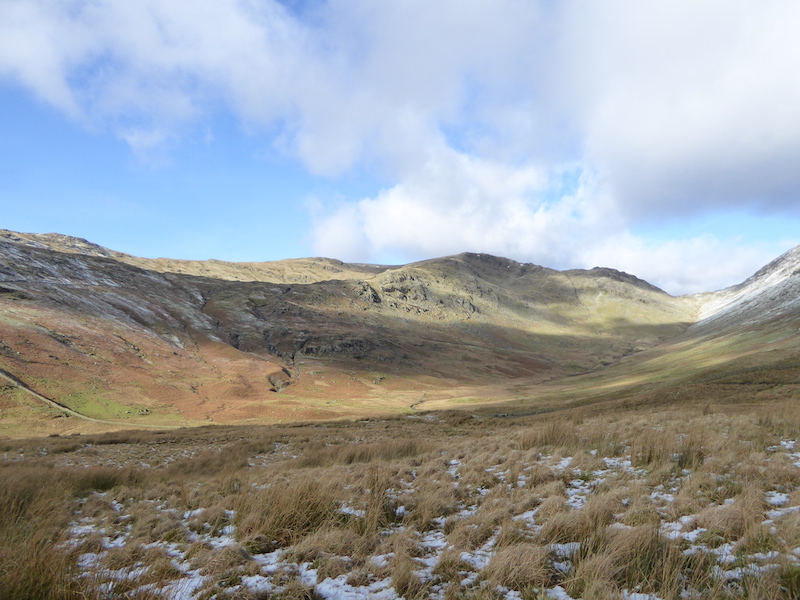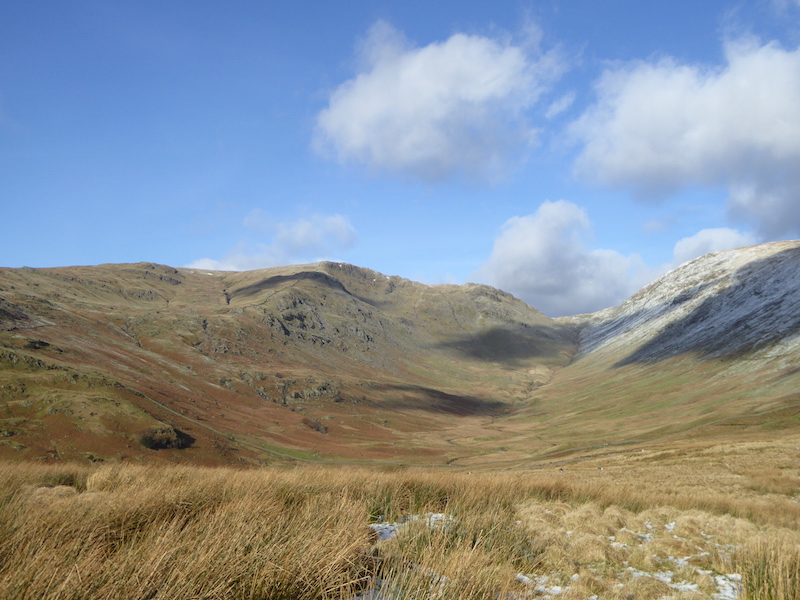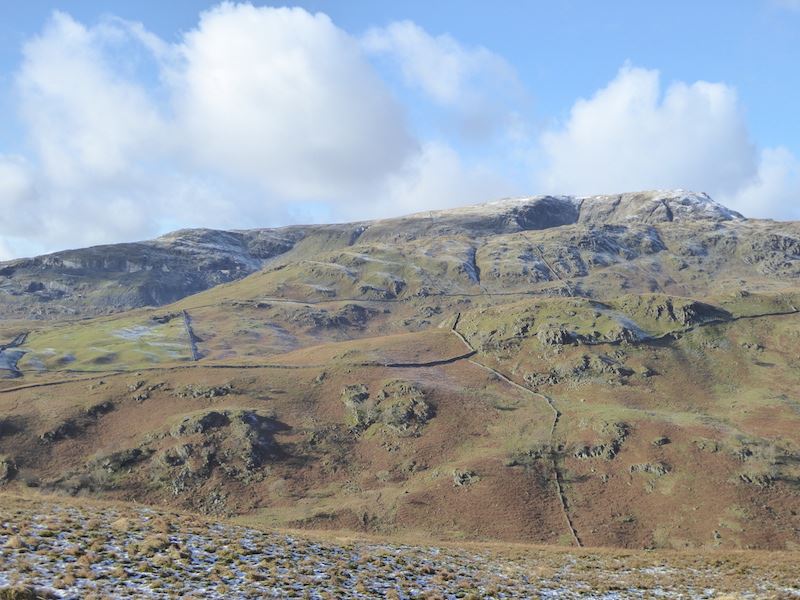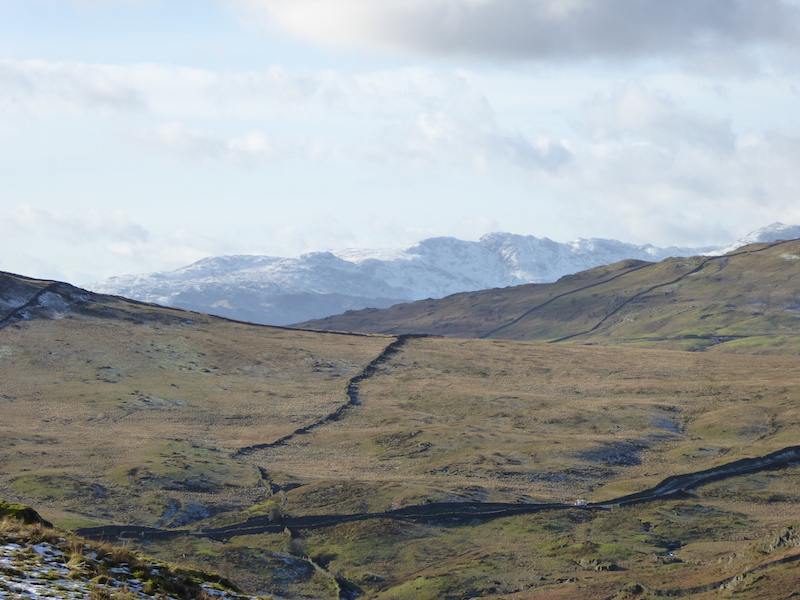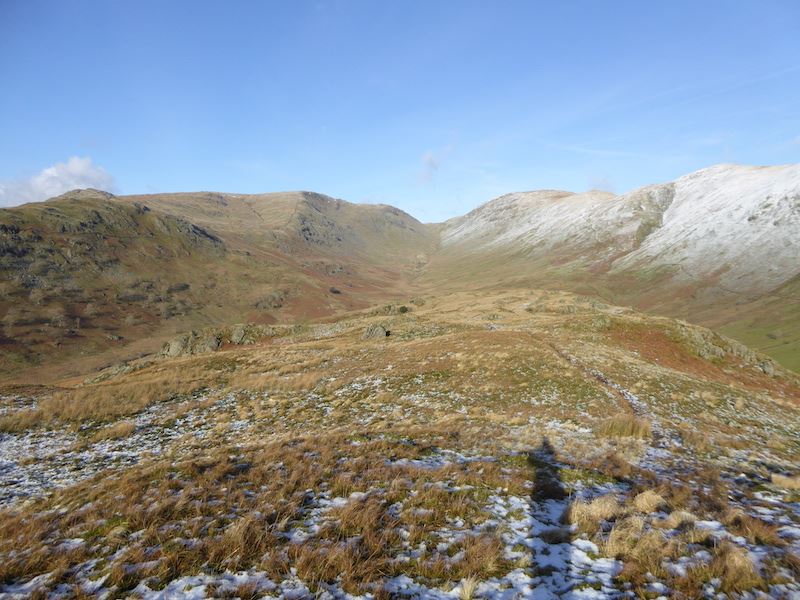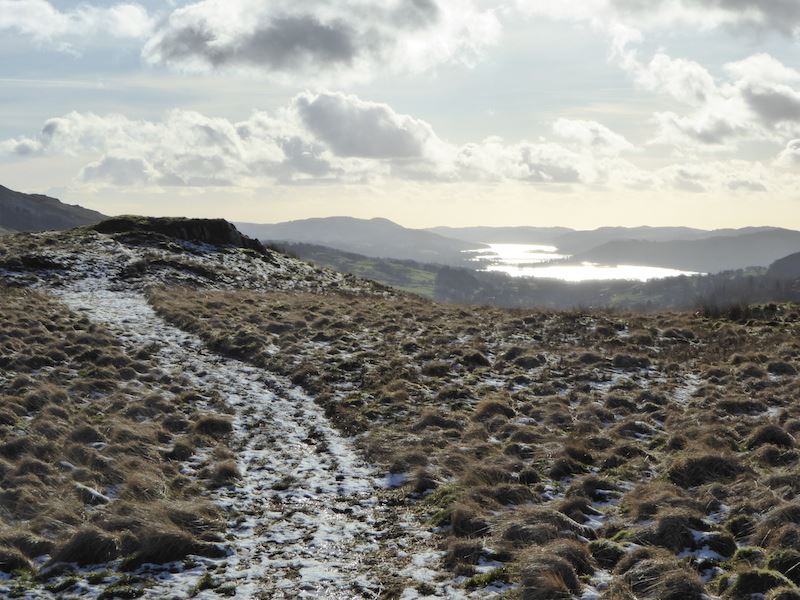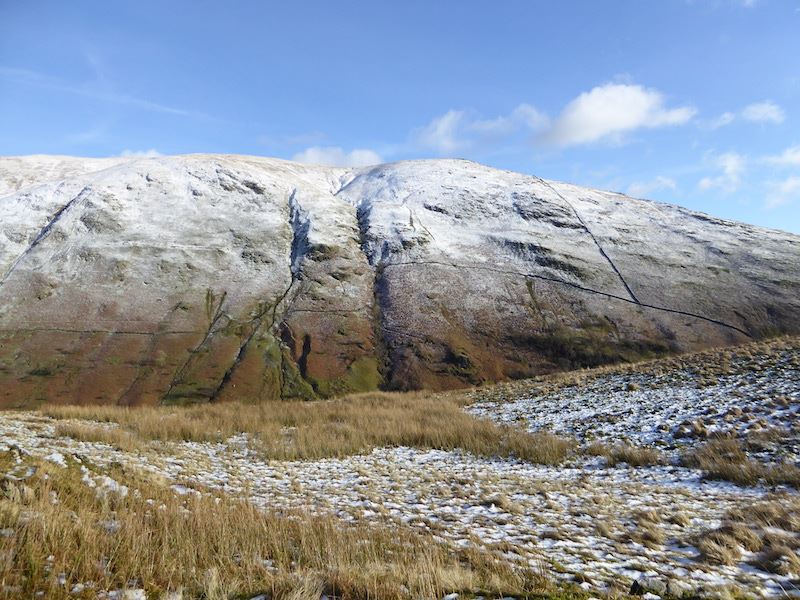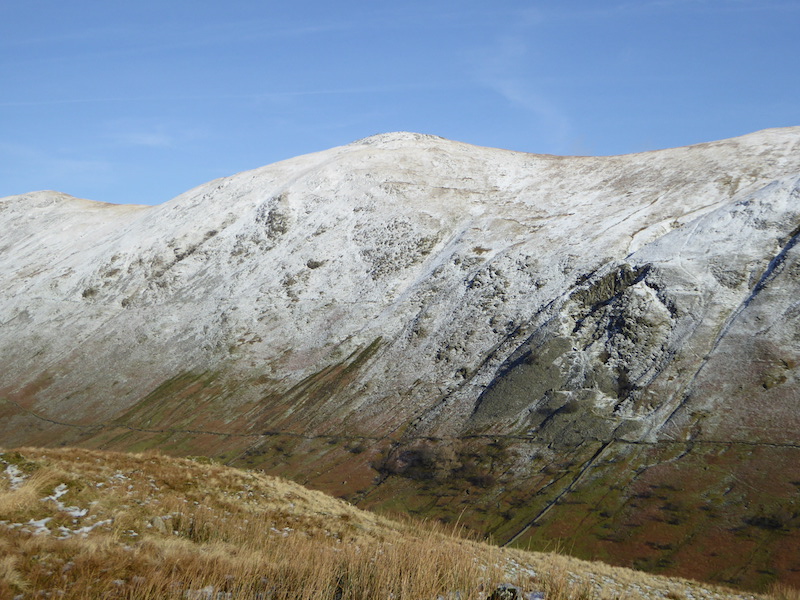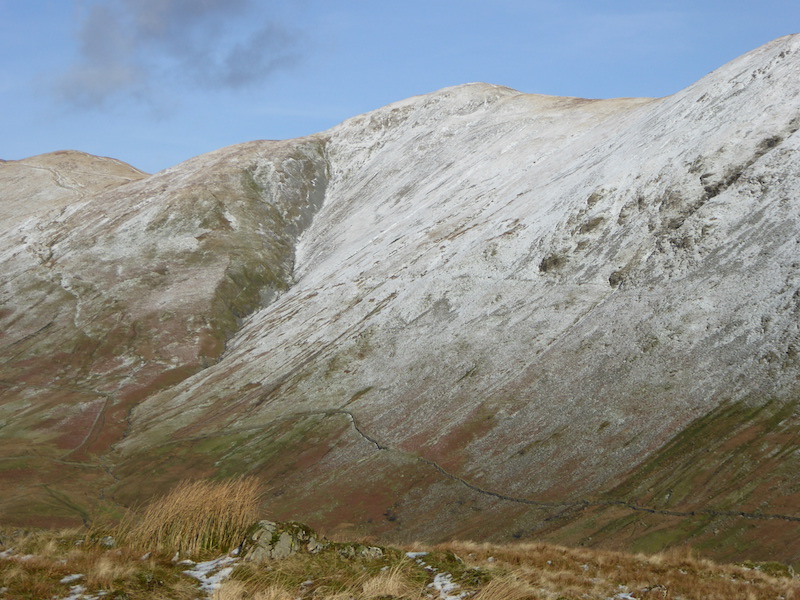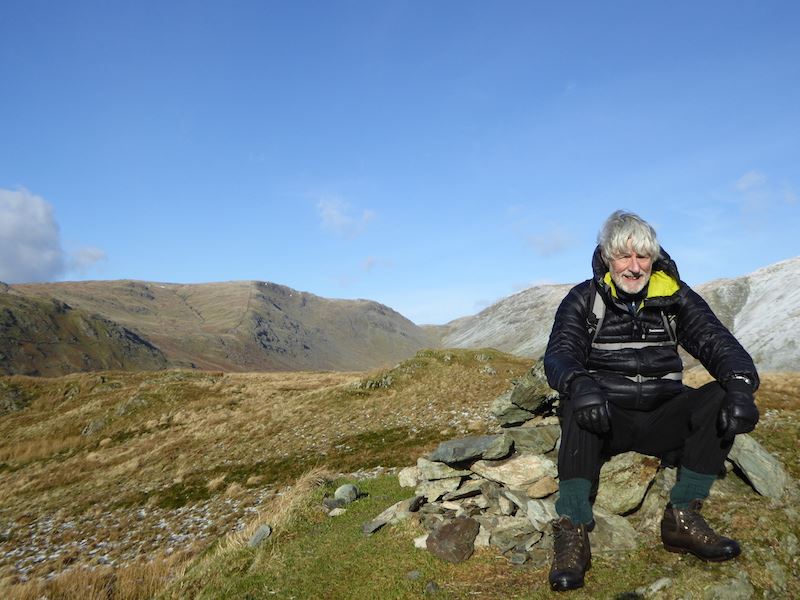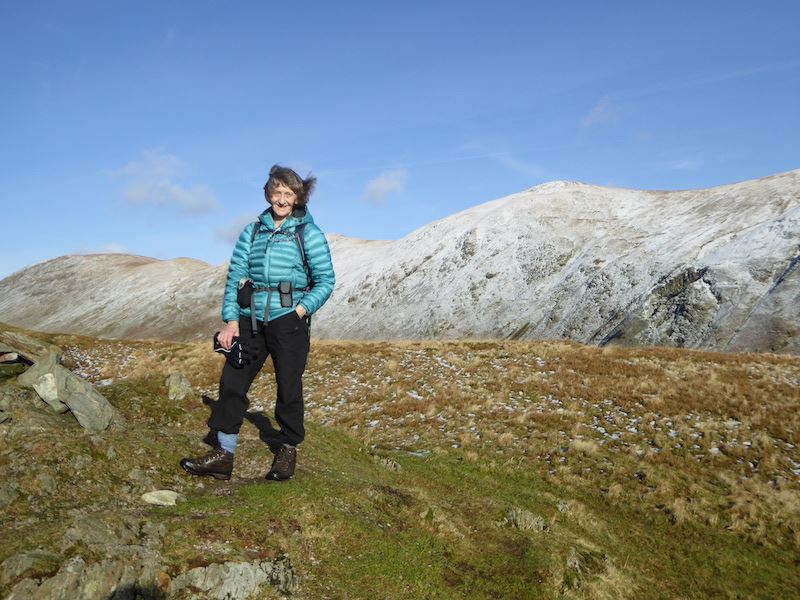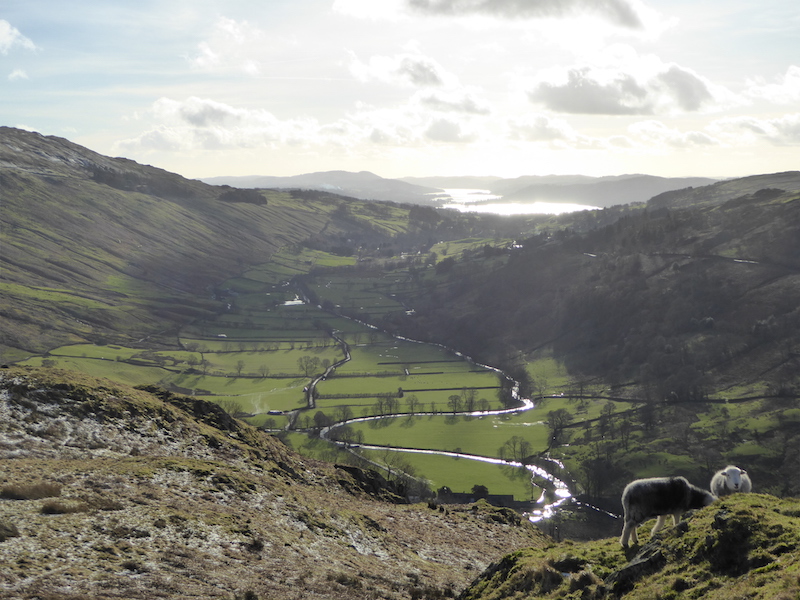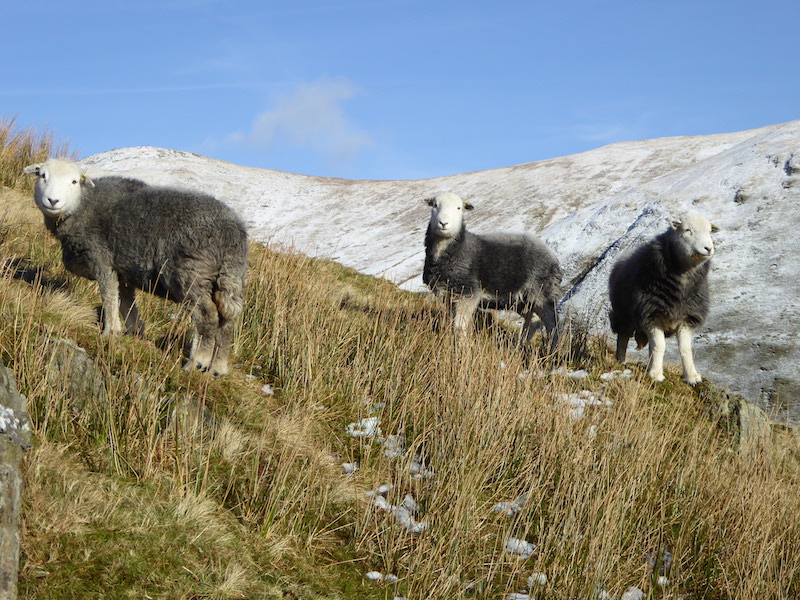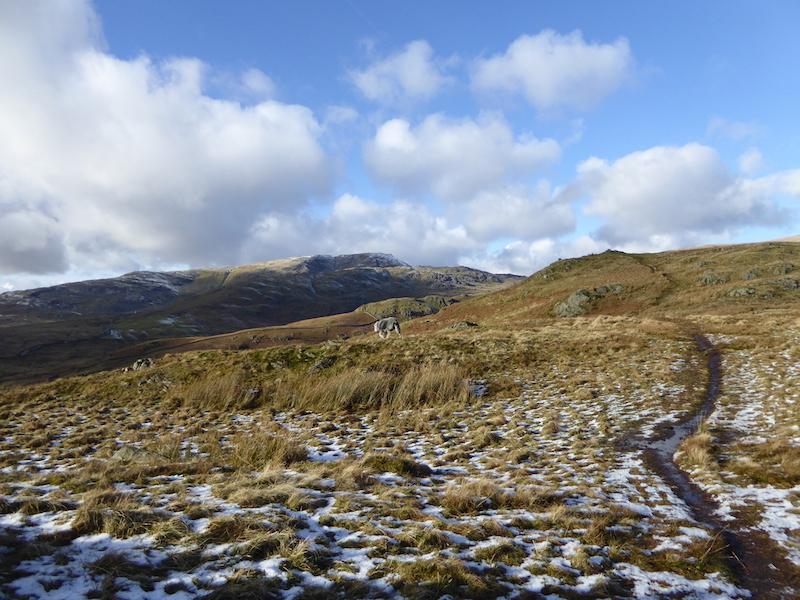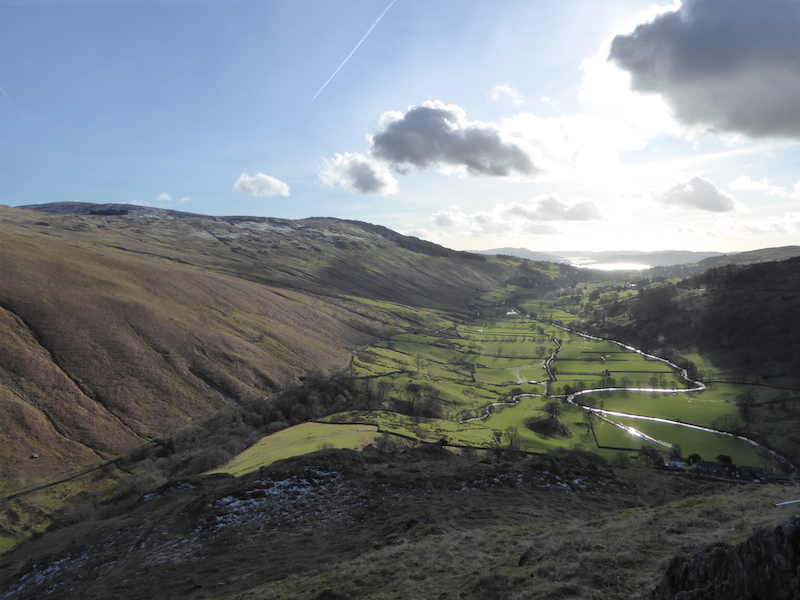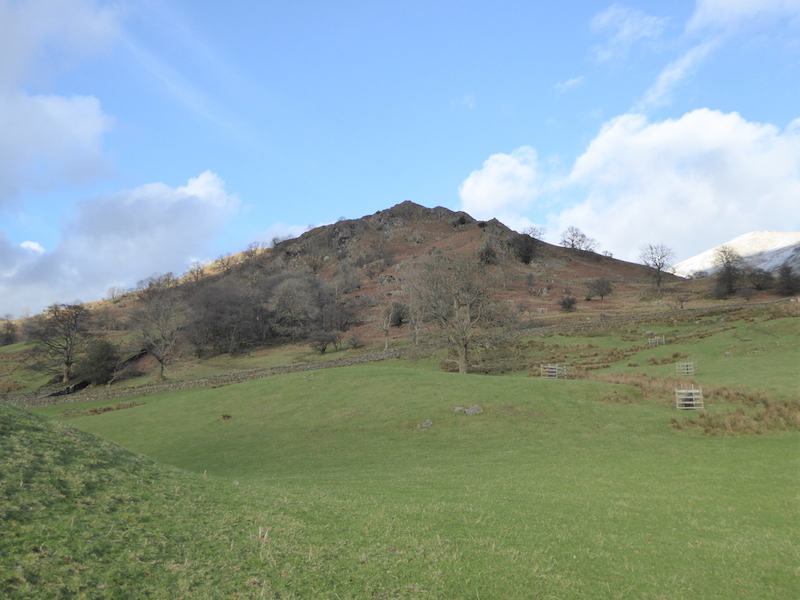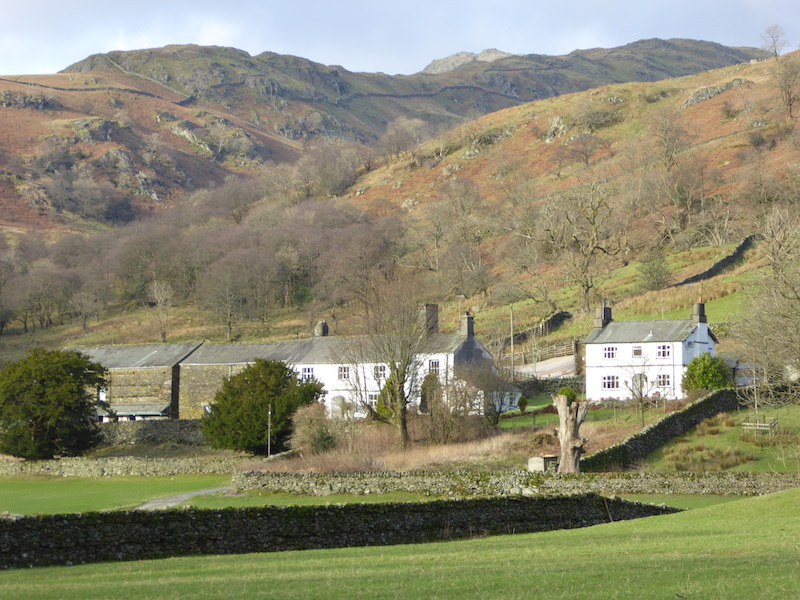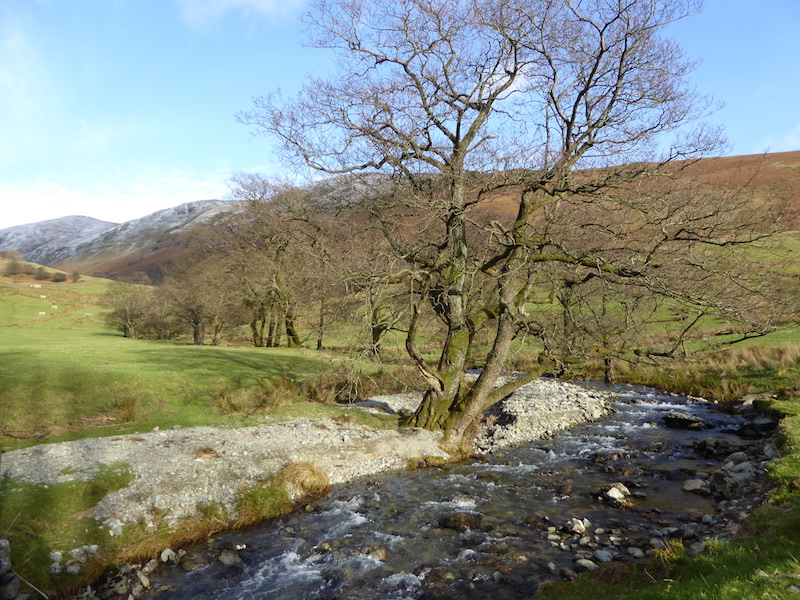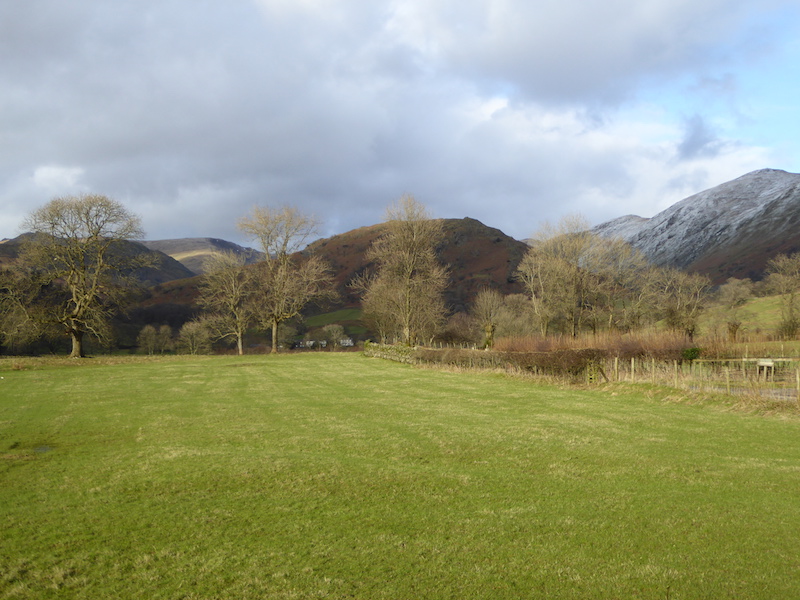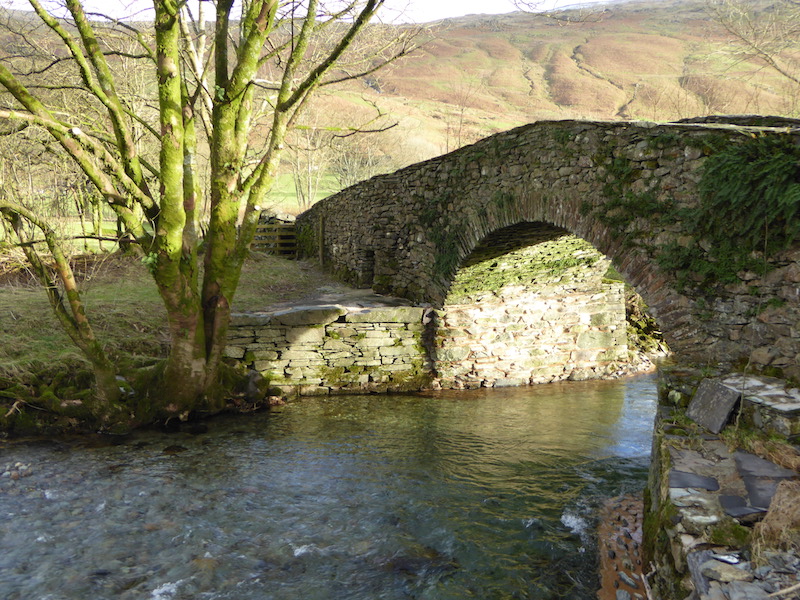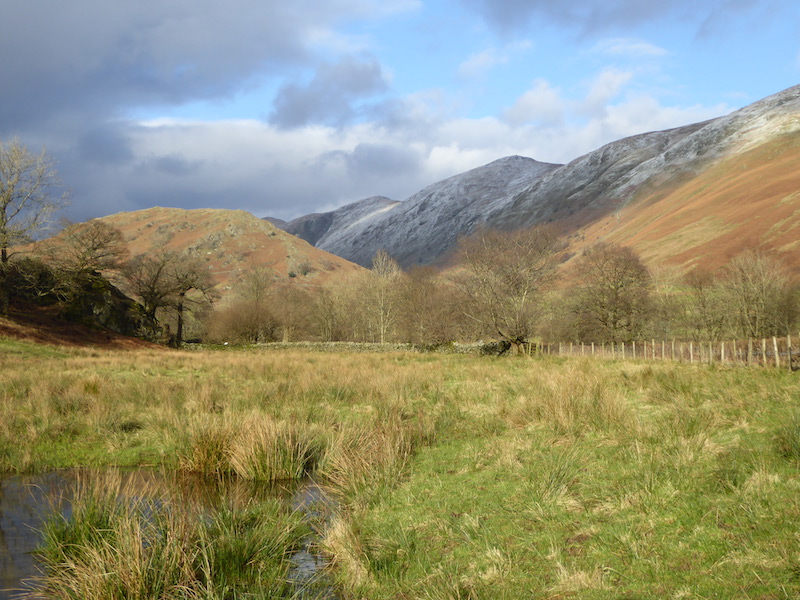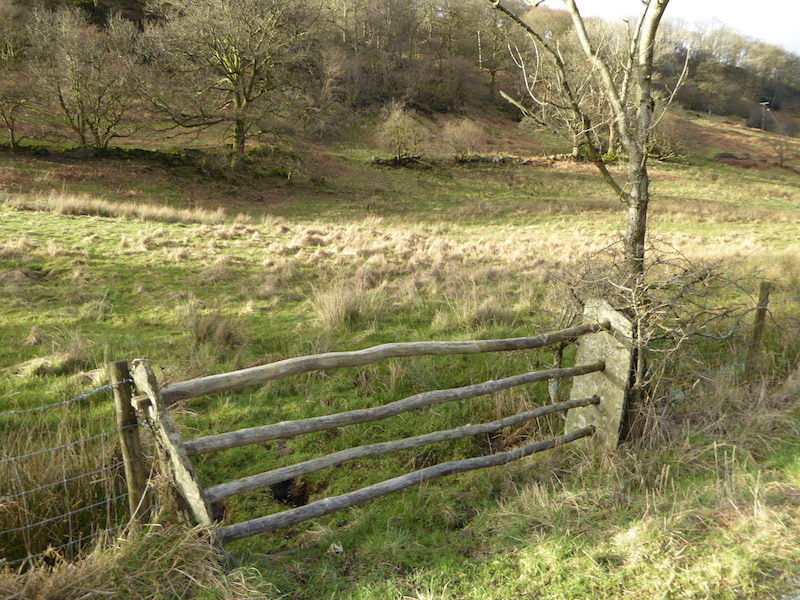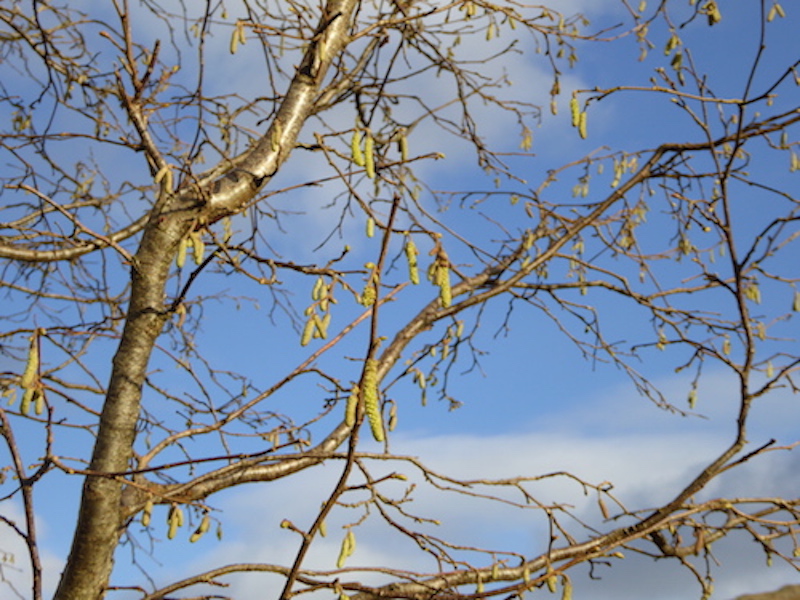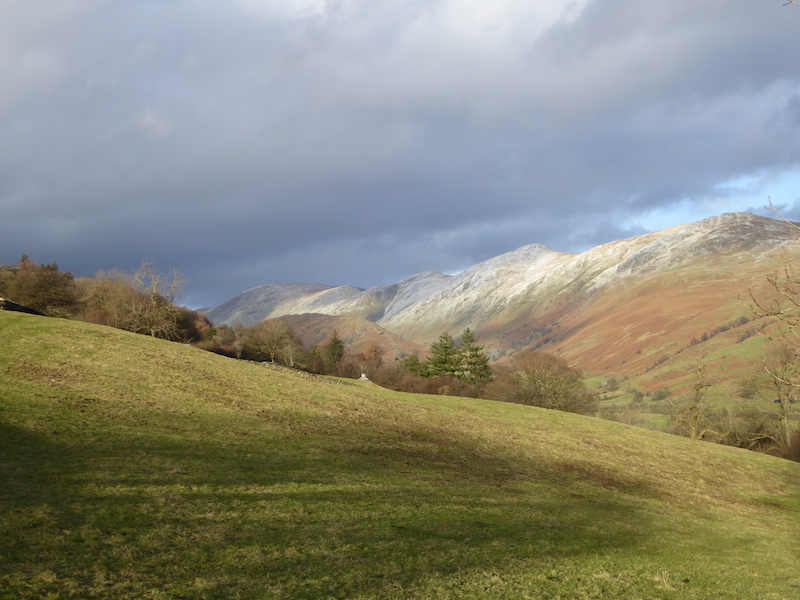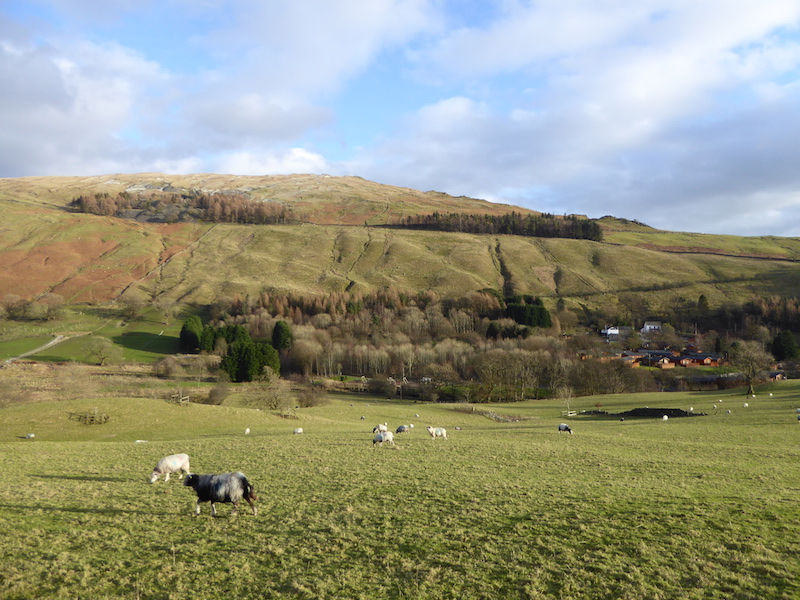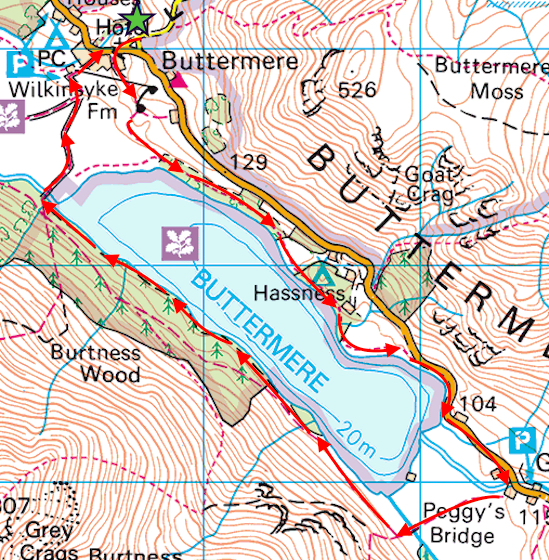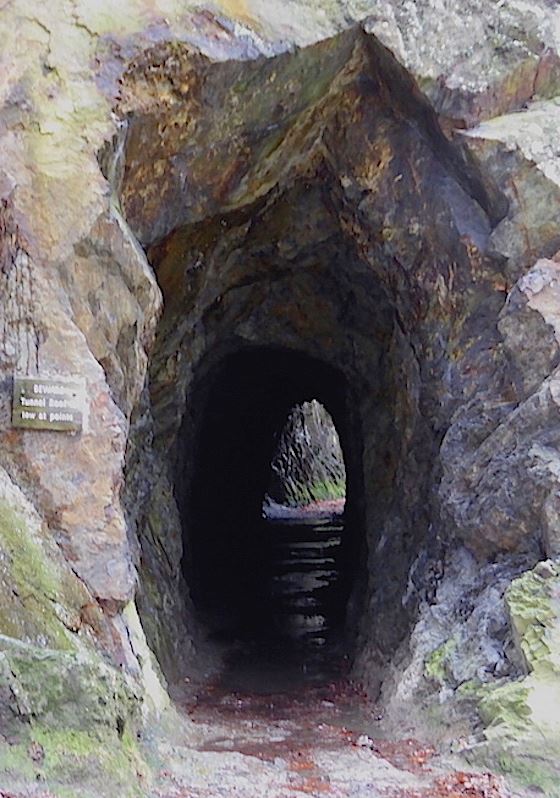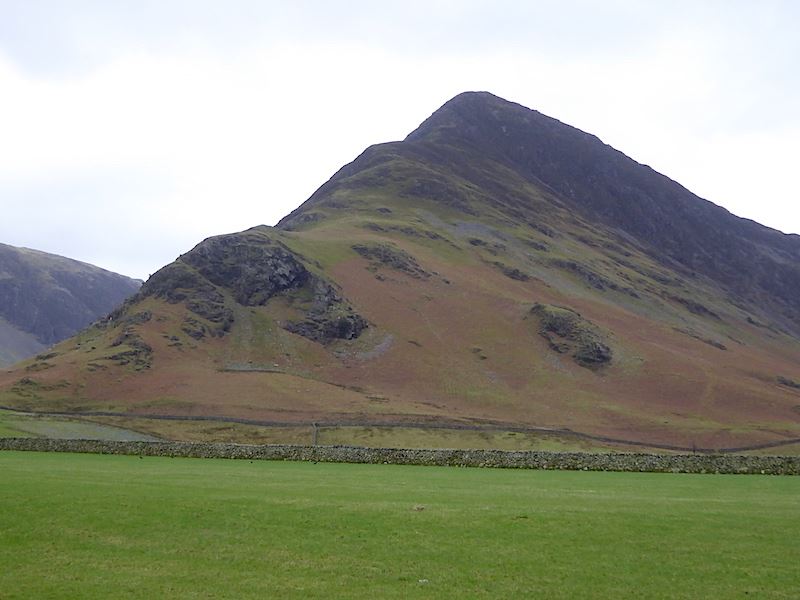Walk Date – 20th January 2016
Distance – 5.7 miles
Weather- dry, sunny, mild, no wind
The snow has gone at low levels but there is still plenty of it up on the fells and with today being forecast as the best day of the week off we went to get some more ‘falling over in the snow’ practice on Sheffield Pike and Glenridding Dodd.
Route


We start by walking up the hill out of Glenridding, with Glenridding Dodd and Heron Pike behind The Traveller’s Rest. Its a bit too early for there to be any travellers resting, but there’ll be plenty later on this afternoon.

Birkhouse Moor as we turn right onto the Greenside Road.

Place Fell beyond Glenridding.

A look into the beck, as we walk up the Greenside road, at the debris brought down during Storm Desmond. Machines are at work digging it all out.

Looking ahead as we walk up the Greenside Road to the old mine. It was like walking along a busy main road up here this morning, as car after car drove up. There is some parking for the Lake District Ski Club up ahead and no doubt that is where they were all heading. About an hour’s walk from the old mine, maybe more in today’s deep snow, there is a ski tow on the north facing slopes of Raise. We also saw some snow-boarders walking up.

Alongside the road is this building built into the side of the hill. Its generally thought to be where the gunpowder, for use at the mine, was stored.

The other side of the old gunpowder store.

We’re above the mine area now and looking back down the beck with a little bit of Ullswater visible below Place Fell.

Ahead of us is Catsycam, taken from the path we took up to Stang End.

Here comes the sun ….. If you know the rest of the song you can sing along if you like.

Looking towards the eastern fells from the path around Stang End above the old Greenside mine. This was now very warm work with the sun on our backs and icy stretches on the path, so the fleeces came off and the micro-spikes went on. Progress was better after that. As we were doing all that a walker came up behind us making for the ski slope on Raise. He was also working up a sweat and mentioned that he was glad he had his skis and boots stored in the ski hut and wasn’t having to carry them up.

We parted company with the skier on the path to ‘The Chimney”, he was going straight on to Raise but we were going over to Sheffield Pike. Here we are at the spoil heap area just below Greenside. We had a short stop here and thought about the possibility of going over to Stybarrow Dodd which is just out of shot to the left of the photo. We decided to go over to Nick Head, the flat area on the skyline, and see what the conditions were like.

Looking over towards Sheffield Pike while we had the Mars Bar stop.

We’ve crossed over the bridge and are slowly making our way up. Slowly because the snow was above knee height and untrodden, apart from animal and ski tracks. We ‘rock-hopped’ wherever possible but at some point the hollows in between the rocks have to be negotiated. Across from us is Catstycam, with the pointed top, on the left and Raise over on the right. The flat area in the middle contains the old spoil heaps, well camouflaged by the snow today.

Straight ahead is the col between Raise, on the left, and Stybarrow Dodd on the right. Between the two is Sticks Pass which leads up to the col.

Sheffield Pike from the area around Nick Head. Here we searched in vain for any sign of previous walkers but not a footprint going over to Greenside could be found, and if we want to go to Stybarrow Dodd we have to walk up Greenside first. Hmmm, its not a great distance but do we really want to blaze an uphill trail through very deep drifts and what can sometimes be a bit of a soggy area? We gave it a go but progress was very slow and arduous, so we abandoned the idea and headed back, using our own footprints, towards Sheffield Pike, which is now there in front of us.

We’re back over on the slopes of Sheffield Pike and looking across to Raise where a number of people were ski-ing and using the ski tow. Its all happening on the shady side so its a bit difficult to see them. We watched the skiers with the binoculars for a while and had a moment of concern when I saw a lone walker suddenly completely disappear beneath the snow in the area where the arrow is. I was just thinking about calling the MRT when he popped up again and managed to get himself out of whatever hole he had fallen into.

Looking across Nick Head to Greenside, ski tracks running across, but no people tracks. Ah well, we gave it a go, but it all looks pretty deep and pristine over there. The track up to the top is clearly visible, its getting to it that’s the problem.

Ski tracks zooming off to the right and Hart Side under a cloak of cloud.

Greenside and Hart Side. When we saw that the cloud making for Greenside we were glad that we hadn’t continued trying to get up there. The metal post is a boundary marker and had the initial M, for Marshall of Patterdale Hall, and the date 1912 engraved on it. I didn’t look to see what the other side had as I was busy having my lunch at the time. A bit of research later revealed that I would have seen an H for Howard of Greystoke Castle.

The cloud is really building up over on Hart Side and, just out of shot on the left, Greenside. Now I’m really glad we didn’t bother trying to get up Greenside.

Greenside again from our lunch spot and a lone walker coming up Sheffield Pike. He suddenly appeared so perhaps he came up via the Glencoyne side.

Lunch over and we head up to Sheffield Pike. Ski tracks and footprints coming from here too. The footprints puzzled me since they petered out just a bit lower down, almost as if their owners had been airlifted off at that point, very strange.

A view of the two Mell Fells from the climb up Sheffield Pike.

Drifts of varying depths everywhere. My walking pole is about three feet long, excluding the handles, so this one is about 18″ deep.

A view along Ullswater from Sheffield Pike summit.

The two Mells fells on the skyline and Gowbarrow Fell, with partial snow cover, over to the right.

Sheffield Pike summit cairn, although its hard to distinguish it, in the snow, from the rocks it stands on.

From the summit looking towards Helvellyn, although its somewhere under all that cloud at the moment.

Descendng through more drifts from Sheffield Pike summit.

We make our way across the top of Sheffield Pike towards Heron Pike. We’ll need to watch where we step as it can be very wet and boggy across here at times.

The drifts were quite deep in many places along here. My walking poles almost disappeared in this one and they still hadn’t touched solid ground.

Heading eastward towards Heron Pike over there at the far end of the plateau, although I shouldn’t call it a plateau as it definitely isn’t an area of fairly level ground.

A view of Ullswater as we walk along.

A panorama of eastern fells on the way to Heron Pike.

Negotiating the many lumps and bumps.

We didn’t have any disasters across here today, even the little tarns were frozen.

Saint Sunday Crag, the high fell on the right, across the frozen tarn.

The cloud has moved and Catstycam can be clearly seen, Helvellyn, which is higher, although it doesn’t look it in this shot, is behind it.

A view of some of the eastern fells, the distinctive flat top, and a proper plateau, of High Street is in the centre of the skyline.

Looking back at the summit of Sheffield Pike. We kept coming across all sorts of patterns in the snow, here’s a shot of one of them …..


What a fabulous view from Heron Pike, below is Glenridding Dodd, part of Ullswater, and layers of eastern fells.

A breathtaking view along Ullswater from Heron Pike.

Looking back at Heron Pike, the path which we’ve just walked down roughly follows the line of the ridge.

From the last part of the descent a look ahead to Glenridding Dodd with Place Fell behind it.

Once down from Sheffield Pike we then made the very short climb up to the summit of Glenridding Dodd. The view along Ullswater from the summit, the light is lovely right now.

Rising above the wall are Heron Pike, on the left, and Sheffield Pike, the summit is set far back and just visible above the flattish area. Behind them to the left is Raise where the skiers are no doubt beginning to think about making the walk back down to their cars.

The summit cairn on Glenridding Dodd.

Place Fell and its neighbouring fells from the summit.

Descending Glenridding Dodd via The Rake, plenty of storm damage evident on the path. The sun has now dropped below the high fells behind us so things look a bit gloomy down below.

The reflections in Ullswater in the centre caught my eye as we descended so I took a very slight detour to get a shot of it.

The sun is setting on Place Fell and the moon is rising above it as we return to Glenridding after a glorious day on the fells.






















































































































